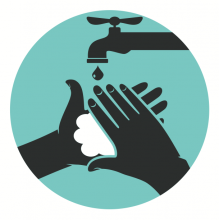Over The Top

This post is an installment in our 52 Health Hinges series. Remember, “Small hinges swing big doors.”
As I’ve learned about how beneficial bacteria is to our lives, I’ve become keenly aware of how obsessed our society has become with antibacterial products.
Have you noticed that antibacterial agents, like triclosan, can be found in some of the craziest things? It shows up in products you’d typically suspect, like hand sanitizer and soap, but it can also be found in toothpaste, bed sheets, cutting boards, sponges, socks, water bottles, and so on. If you can make it up, there’s a chance that it comes in an antibacterial form.
But here’s the deal. The American Medical Association and the Food and Drug Administration have found that using antibacterial soaps does not work any better than plain soap and water at preventing the spread of bacteria (Source).
In short, these antibacterial products are overkill.
Beyond that, they’re harming us.
According to Mary Ruebush, PhD, an award-winning professor of immunology and microbiology, “Because of some common misunderstandings about how illness works, we’ve begun to mistake any and all microbes for public enemy No. 1. But if bacteria itself were the problem, we’d all be long gone by now.”
She continues, “… the modern obsession with cleanliness, along with an increasing tendency to stay indoors in germ- and parasite-free environments, [is] leading to weaker immune systems and an increase in autoimmune disorders. The immune system is like an athlete: To become strong and adept, it needs training and practice. Hyper-sanitized environments deny it that opportunity and keep it sedentary and out of shape.”
Let’s focus this conversation around triclosan, a commonly used (perhaps the most commonly used?) antibacterial agent.
Triclosan has been proven to contribute to:
- Endocrine and thyroid dysfunction (Source 1, 2, 3)
- Asthma (Source 4)
- Cancer (Source 5)
- Liver toxicity (Source 6)
Knowing that the AMA and FDA have found that antibacterial soaps aren’t any more effective than plain ol’ soap and water, is there any reason to use these products in your home?
I don’t think so!
Thankfully, states have started to ban triclosan-containing products, but a) not all states have passed the laws and b) even if your state has banned triclosan, it can take time for the law to phase in.
Here are some alternative household disinfectant cleaners:
- Mild castile soap and water (ahhh, the simplicity!)
- 50% mixture of distilled water & white vinegar in a spray bottle
- DIY Mixture of the following in an unused spray bottle:
- 1 cup filtered water
- 3/4 cup white vinegar
- 2 teaspoons rubbing alcohol
- 8-10 drops essential oils of choice: (thyme, tea tree, lavender, oregano, clove, rosemary)
- Green Shield Organic All Purpose Cleaner
- Whole Foods Market All Purpose Cleaner
- Ava Anderson All Purpose & Glass Cleaner
Also, take a look at the Environmental Working Group’s household cleaners database. Type in the products that you’re using and see if you’re currently dealing with toxic or harmful chemical ingredients, and use the database to find cleaner alternatives.
1 Betts KS 2011. “Chemical Count: Quantifying Exposures in Pregnant Women”. Environ Health Perspect 119:a258-a258. http://dx.doi.org/10.1289/ehp.119-a258b
2 Dann AB, Hontela A. Triclosan: environmental exposure, toxicity and mechanisms of action. J Appl Toxicol. 2011 May;31(4): 285-311. doi: 10.1002/jat.1660.
3 Rodríguez PE, Sanchez MS., Maternal exposure to triclosan impairs thyroid homeostasis and female pubertal development in Wistar rat offspring. J Toxicol Environ Health A. 2010;73(24):1678-88.
4 Dodson RE, Nishioka M, Standley LJ, Perovich LJ, Brody JG, Rudel RA 2012. Endocrine Disruptors and Asthma-Associated Chemicals in Consumer Products. Environ Health Perspect :-. http://dx.doi.org/10.1289/ehp.1104052
5 Rule KL, Ebbett VR, Vikesland PJ (2005). “Formation of chloroform and chlorinated organics by free-chlorine-mediated oxidation of triclosan”. Environ. Sci. Technol. 39 (9): 3176–85. doi:10.1021/es048943
6 Geens T, Neels H, Covaci A. Distribution of bisphenol-A, triclosan and n-nonylphenol in human adipose tissue, liver and brain. Chemosphere. 2012 Jan 23
Add comment